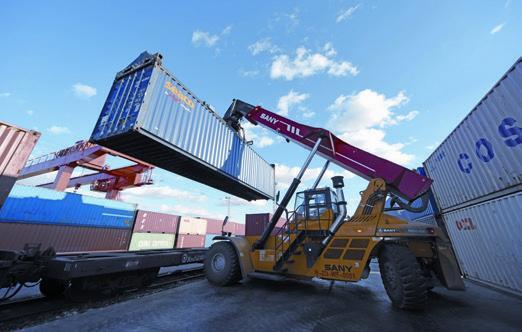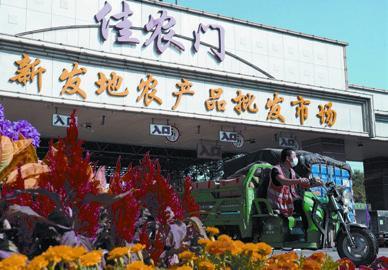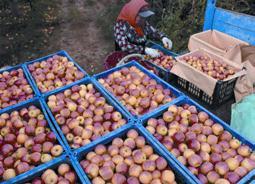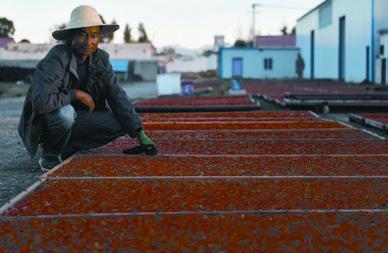HITTING A NEW HIGH

A crane transports containers at the Port of Erenhot in Inner Mongolia Autonomous Region, north China, on September 3.
The number of China-Europe freight trains hit a record high of 1,247 in August, up 62 percent year on year, according to the China State Railway Group on September 9.
It marked the sixth consecutive month the number registered double-digit growth.

Market Reopens
The entrance of Xinfadi Market, Beijings largest agricultural produce wholesale market, on September 7. The north area of the market reopened on September 6, marking full resumption of business after it was temporarily shut down due to the novel coronavirus disease in June.
Cleaner Air
The reduction in the concentration of PM2.5, a fi ne particulate matter, in the Beijing-Tianjin-Hebei area in north China is among the most substantial air quality improvements ever achieved in the world in the past fi ve to six years, according to a report by the World Bank.
The World Bank team on Pollution Management and Environmental Health released the report at the 2020 Beijing International Forum for Metropolitan Clean Air and Climate Actions on September 8.
Jostein Nygard, a senior environmental specialist of the World Bank, said the management of fi ne particulate matter, particularly that from industrial processes, power plants and clean household fuels, heavy-duty vehicles, passenger cars and industrial combustion sources, has worked well.
Zhang Dawei, Deputy Director of the Department of Air of the Ministry of Ecology and Environment, announced at the forum that the average annual concentration of PM2.5 in Beijing dropped from 89.5 micrograms per cubic meter in 2013 to 42 micrograms in 2019, a decrease of more than 50 percent, while the carbon emission intensity fell by 43 percent from 2010 to 2019.
New Railway
A new railway passing through the southern region of Xinjiang Uygur Autonomous Region in northwest China has made a foray into the countrys largest desert as transport construction picked up pace after effective containment of the novel coronavirus disease (COVID-19) locally.
Workers on September 7 started laying tracks on a section of the Hotan-Ruoqiang Railway in Qiemo County, Bayingolin Mongolian Autonomous Prefecture, located in the southern rim of the Taklimakan Desert.
Sand-proof tarpaulins are being used to shield major parts of construction vehicles from sandstorms, according to Zhang Gang, a project manager with China Railway 14th Bureau Group Co. Ltd. overseeing the construction.
The railway spans more than 825 km, with a designed speed of 120 km per hour. After completion, it will form a part of the third major transportation line connecting east and west Xinjiang.
The railway will usher in a new era for fi ve counties situated along the line that never had any rail connectivity. “Its a historic moment for us as the railway will accelerate the growth of the local economy,” Xu Kai, a top offi cial of Qiemo, said.
Background Check
Preschools must carry out background checks when hiring staff workers, according to a draft law on preschool education unveiled by authorities on September 7 to solicit public opinion.
Individuals barred from working at preschools include those deprived of political rights, those who have a criminal record as well as people who have received administrative penalties for child abuse, sexual abuse, sexual harassment, and relevant acts, according to the draft law unveiled by the Ministry of Education.
Those who have records of illegal behavior such as drug and alcohol abuse and gambling, and people suffering from mental illness or having a history of mental illness, or having records of acts seriously violating teachers ethics, are also banned.
Millet Museum
Chinas fi rst millet museum opened on September 7 in Aohan Banner of Chifeng, Inner Mongolia Autonomous Region in north China, where the worlds oldest millet, dating back about 8,000 years, was discovered.
Carbonized millet grains unearthed by archaeologists two decades ago are exhibited in the museum with a fl oor space of 7,700 square meters. The exhibition area of the museum features the cultivation of millet in China and the history of dry farming.
In 2012, the Aohan dryland farming system was listed among Globally Important Agricultural Heritage Systems by the Food and Agriculture Organization of the United Nations. In 2014, Aohan was recognized as Chinas “hometown of millet” by the Chinese Food Industry Association.
Demand for millet has been rising rapidly in China, as it is considered a healthy alternative to rice. Millet-made cakes, ice cream and beverages have emerged as trendy delicacies in the market.
National Parks
Guangdong Province in south China will build two national parks, namely the national parks of Nanling and Pearl River Estuary, according to the Forestry Administration of Guangdong.
The provincial government has established a leading group to coordinate the construction of the two parks.
According to the group, the Nanling National Park will cover nine county-level regions and 30 villages and townships in the cities of Shaoguan and Qingyuan, with a total area of about 2,121 square km. The park will encompass 18 natural reserves and state-owned forest farms.
The Pearl River Estuary National Park plan has not been revealed.
Guangdong has established 1,359 natural reserves that are above the county-level, the most among provincial-level regions in China.

A Good Harvest
A farmer classifi es apples in Weichang Manchu and Mongolian Autonomous County in Hebei Province in north China on September 8. Local farmers have been growing apples in recent years taking advantage of ample sunshine and the big temperature difference between day and night.
Health Centers
Five regional medical centers will be opened to promote health services for children, according to the National Health Commission (NHC) on September 4.
The centers will be based at leading childrens hospitals in Liaoning Province in the northeast, Zhejiang Province in the east, Guangdong Province in the south, Shaanxi Province in the northwest, as well as Chongqing Municipality and Sichuan Province in the southwest, the NHC said.
In coordination with the national center for childrens health, the regional centers will improve medical treatment, scientifi c research, and preventive healthcare for children in these regions.
Chinas national center for childrens health was established in both Beijing and Shanghai in 2017.
Online Renting
About 96.8 percent of college graduates chose to rent apartments online this year, according to a recent survey by China Youth Daily.
Due to the impact of the COVID-19 epidemic, it has become increasingly diffi cult to view an apartment on site before signing the lease. Many real estate agencies have adopted virtual apartment viewing, enabling potential tenants to see the apartments online through pictures, virtual reality technology and videos. Among the 1,974 college graduates surveyed, only 48.4 percent have tried on-site apartment viewing.
“Im satisfi ed with online apartment renting, which is effi cient and convenient; however, there are some drawbacks as well,” Chu Wenjing, a 2020 graduate, said, adding that some apartments look more spacious online than they actually are.
The survey showed that 74.2 percent of graduates are content with their experience of online house renting, with those in second-tier cities having the best experience.
More than 80 percent of the respondents hoped contracts for online apartment renting could be standardized to protect the rights and interests of tenants, while 72.1 percent suggested strengthening supervision.

Economic Vitality
A Web hostess live-streams at an amusement park in Changxing, a county in Zhejiang Province in east China, on September 8. Activities were held that day as part of the national consumption promoting month to boost consumers confi dence and stimulate consumption.
EV Market
According to a market assessment published by the German Center for Automotive Research (CAR) on September 7, China is on its way to become the biggest market for electric vehicles (EVs) again by the end of the year.
In total, almost 400,000 fully electric cars and plug-in hybrids were sold in Europe in the fi rst half of the year. In China, only 7,200 fewer electrifi ed vehicles were sold in the same period, according to CAR.
In terms of sales of all-electric vehicles in the fi rst half of the year, China was already a market leader while more plug-in hybrid cars were sold in Europe, it said.
China made a great leap in allelectric vehicles with Tesla. CAR data shows that the Tesla Shanghai gigafactory contributed the sales of almost 50,000 fully electric cars in China in the fi rst half of the year.
China and Europe were “decisive for the global breakthrough of electric mobility,” Ferdinant Dudenhoefer, Director of CAR, said, noting that the two regions were“signifi cantly supporting emissionneutral mobility.”
Industry Catalogue
Items on the industry catalogue will be signifi cantly increased to encourage foreign investment and help foreign-funded fi rms to receive benefi ts from preferential policies, Vice Commerce Minister Wang Shouwen said on September 8.
The Ministry of Commerce will continue to implement the negative list for foreign investment and expand the scope of businesses encouraging foreign investment, sharing the market and opportunities in China with foreign investors, according to Wang at the launching ceremony of an online international fair for investment and trade.
Wang also said that the ministry will further improve the foreign investment service system, help foreign-funded fi rms solve diffi culties and well implement the Foreign Investment Law and regulations to create a stable, fair, transparent and predictable business environment.
Ministry data showed paid-in foreign direct investment (FDI) on the Chinese mainland rose 0.5 percent year on year to 535.65 billion yuan($78.3 billion) during the JanuaryJuly period.
In July, FDI expanded 15.8 percent year on year to 63.47 billion yuan ($9.06 billion), marking the fourth consecutive month of positive growth.

Health Products
A worker dries goji berries, also known as wolfberries, in a village in Delingha, Qinghai Province in northwest China, on September 2.
Industrial Internet
The Committee for the Promotion of Industrial Internet was launched in Beijing on September 4.
It will focus on strategic research, standard system, industry solutions and other key areas of the industrial Internet to lay a solid foundation for consistent and healthy development in China, a report by Xinhua News Agency said.
It will also promote innovations in areas including workplace safety, energy, coal production and medical care. It will strengthen gathering, sharing and value exploration of big data in the industrial Internet.
The committee called for efforts to encourage enterprises to participate in the construction of 5G, big data centers and other new infrastructures, as well as improve intellectual property protection and deepen international cooperation.
Better Procurement
The government is setting up an open and transparent public procurement system and integrate into the international public procurement market, an offi cial said on September 8.
According to Zhang Shaogang, Vice Chairman of the China Council for the Promotion of International Trade (CCPIT), engaging in the huge market of international public procurement will help enterprises make full use of both domestic and international markets and resources, and strengthen cooperation with countries, regions, and international organizations.
Over 7,000 Chinese suppliers have registered at the basic level for the UN, making China second in the world in terms of the number of such suppliers, Zhang said, adding that there is still great potential for their participation in UN procurement opportunities.
He called for better introduction to rules and processes to encourage enterprises to take part in international public procurement,establishing platforms for Chinese enterprises to communicate with international organizations for cooperation, and making concerted efforts to enhance transparency, openness and impact of international public procurement.
The CCPIT will work with other organizations in encouraging Chinese companies to participate more in the procurement and trade of international organizations such as the UN, and make contributions to boosting recovery of the world economy, advancing global economic governance and building an open world economy.

Indigenous Technology
The No.5 nuclear power unit in Fuqing, Fujian Province in southeast China, on September 3, the day before fuel loading started. It is Chinas fi rst nuclear power unit using Hualong One technology, a domestically developed third-generation reactor design. The unit, which began construction in 2015, is expected to start operation this year.
Agricultural Fair
The 27th China Yangling Agricultural Hi-Tech Fair is scheduled to be held between October 22 and 26 in the northwestern province of Shaanxi.
According to organizers, the fair will have online and offl ine sessions this year. Offl ine events will take place in the Yangling Agricultural Hi-Tech Industrial Demonstration Zone, with the attendance of government offi cials, experts and entrepreneurs.
With the theme of “innovation leads high-quality development,”the fair will feature 14 major activities, including a round-table conference on the development of modern agriculture in Shanghai Cooperation Organization (SCO) member states.
Established in 1994, the fair is one of the largest and most infl uential events on agricultural science in China.

Elderly Care
A woman waters the plants on the balcony of an apartment for the elderly at a community in Anji County, Zhejiang Province in east China, on September 9. The county is developing the elderly care industry, creating more job opportunities for villagers and promoting rural tourism.
E-Commerce Bases
Vice Minister of Commerce Qian Keming gave licenses to 15 new national e-commerce demonstration bases at the China National Convention Center in Beijing on September 5.
The national e-commerce demonstration bases, with an aim to foster the fast development of the sector, are clusters of local e-commerce companies and entrepreneurship and innovation platforms for the e-commerce industry.
The new ones bring the total number of offi cial e-commerce demonstration bases to 127. China pays high attention to the development of the e-commerce, Qian said.
The sector has played a signifi cant role in helping fi ght against the COVID-19 epidemic, driving consumption recovery and smoothing industrial and supply chains of foreign trade, especially since this year, according to Qian.
CPI and PPI
Chinas consumer infl ation eased in August as economic activities gradually recovered after effective epidemic containment in the country, offi cial data showed on September 9.
The consumer price index (CPI), the main gauge of infl ation, grew 2.4 percent year on year last month, moderating from the 2.7-percent gain in July, according to data from the National Bureau of Statistics(NBS).
On a monthly basis, consumer prices edged up 0.4 percent. Food prices, which account for nearly one third of weighting in Chinas CPI, climbed 1.4 percent last month.
Producer price defl ation continued to ease in August amid a recovery in industrial activities and market demand, the NBS data showed.
Producer price index (PPI), which measures costs for goods at the factory gate, fell 2 percent year on year in August, according to NBS. The reading narrowed from the 2.4-percent drop in July.
Month on month, the PPI climbed 0.3 percent in August.
NBS senior statistician Dong Lijuan attributed the rise to “improving industrial production and recovering market demand.”
“International prices of commodities such as crude oil, iron ores and nonferrous metals extended their upward momentum, leading to price increases for domestic industrial products,” Dong said.

